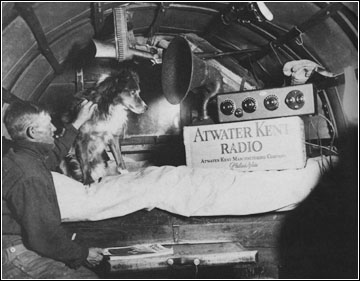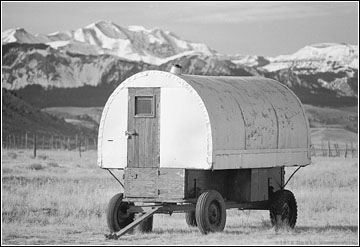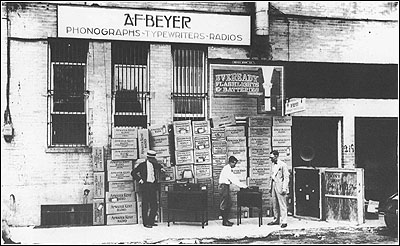Of Old Radios And Related Items--Published Monthly
The Sheepherder, His Dog, and His Radio
BY DOROTHY SCHECTER FROM INFORMATION PROVIDED BY
BRUCE BERGSTROM AND DEWEY VANDERHOFFWeb Edition
A sheepherder and his dog -- certainly not Nipper -- listening to an Atwater Kent Model 20 in a covered wagon? Such a scene can do no less than fire the imagination of anyone interested in radio history. When Bruce Bergstrom sent us a copy of the photo, shown in Figure 1, we simply had to pursue the story.
And the story is set in Wyoming. The photo, probably taken about 75 years ago, is one of many by Charles J. Belden, (1887-1966), known as the "Cowboy Photographer," in a wonderful book by Bob Edgar and Jack Turnell entitled Brand of a Legend. The Belden Collection is housed in the Buffalo Bill Historical Center in Cody, Wyoming.
Other photos in the book, including the one in Figure2, are by Dewey Vanderhoff of Cody, Wyoming, a contemporary photographer, who is also credited with the beautiful layout of the book. This photo shows the exterior of a wagon just like the one in Figure 1, with the exception of the rubber tires needed for modern roads. The wheels of earlier times were wooden.
According to Dewey, these wagons were common on big Wyoming ranches. Today, people are buying them and restoring them -- space constraints are obviously not an issue for wagon collectors. When he took the photo in 1976, Dewey actually lived in the wagon while signing in hunters for the fall hunting season.

Figure 1. "Sheepherder Inside his Wagon with Dog" by Charles J. Belden (1887-1966). Courtesy of the Buffalo Bill Historical Society, Cody, Wyoming. The Charles Belden Collection.
Background of the "Legend"
Brand of a Legend is a chronological history of the Greybull River area of Meeteetse, Wyoming, and particularly of the Pitchfork Ranch, one of the state's oldest and most historic ranches. The founder of the Pitchfork Ranch, the setting of the sheepherder photo, was Count Otto Franc von Lichtenstein (Otto Franc), a member of a German royal family, who had immigrated with his two brothers to New York in 1866. After eleven years with them in the banana importing business, Otto set out to find a different life.
He certainly found it in Wyoming where his search for land in 1878 ended in the valley of the Upper Greybull River. Rich in grass, water, and wildlife, this land had all the makings of ranching success in the wilderness of the 19th century.
In 1903, L.G. Phelps, entrepreneur and investor, purchased the Pitchfork Ranch from the estate of Otto Franc. Otto, who had set out to hunt duck, was found shot beside a fence in a field, his gun still leaning against a barbed wire fence. The death was ruled accidental, but many thought this unlikely and suspected foul play -- a Wild West story in itself, it seems.
Pitchfork grew to encompass 250,000 acres, which Phelps operated until his death in 1922. By this time, seven ranches had been added to the Phelps holdings, all under the legendary Pitchfork brand.
Brand of a Legend is dedicated to Phelps' daughter, Frances Phelps Belden, who is described as "the guiding light at the Pitchfork for 75 years." In the changing times of the 20th century, the fortunes of the ranch rose and fell. Frances' brother Eugene and her husband, photographer Charles Belden, both M.I.T. graduates, had tried to run the ranch together. However, it was not a congenial partnership, and both had other interests.
Eugene, an inventor, was not interested in money matters, while Charles had become well known for his photography and toured widely for National Geographic. It was Frances who was uncompromising in the effort to keep the ranch in her family. The authors call her one of Wyoming's "great pioneering ladies." (Co-author Jack Turnell, incidentally, married a Belden granddaughter and became manager of the ranch.)
In 1945, the ranch was divided between the two branches of the Phelps family -- the Eugene Phelps family and the Frances Phelps Belden family. Eventually, the Frances Belden branch bought back the other holdings and Frances' daughter Annice Belden Somers, her children, and grandchildren continued the business. To this day, they are still running cattle on the legendary Pitchfork Ranch.
Cattle and Sheep
The first cattle brought to Pichfork by Otto Franc were Herefords, a breed which L.G. Phelps and his descendants continued to upgrade. Eventually, the Pitchfork herd became a commercial leader.

Figure 2. A typical Wyoming ranch sheep wagon from the early 20th century, converted from horse-drawn to vehicle use, as noted by the rubber truck tires that replaced wooden wheels. Photographed at the Pitchfork Ranch in 1976 by Dewey Vanderhoff.
In the early days of Pitchfork, as many as 100 cowboys were employed. They were a strong, proud lot. Though their lives have frequently been romanticized in literature and movies, cowboys, in fact, faced endless days of hard, dangerous work. They cared for the cattle year round, feeding and keeping them healthy in winter, and then in spring, dealing with the arduous job of calving.
Then came branding and moving the cattle to the summer upper range. Finally, the task of shipping the herds to the market began in the fall, and in the early years, the cattle were trailed to the railroad in Cody 30 miles away. With few comforts of home, the cowboys were on the trail for six weeks.
Phelps also introduced sheep to the ranch, and eventually, the sheep outnumbered the cattle. Sheep offered two cash advantages per year -- mutton and wool -- and often the sheep carried the ranch through hard times.
However, sheep are harder to raise than cattle, as they are more vulnerable to severe weather and other predatory animals. By 1964, the sheep numbers had dwindled, the herd was sold, and the ranch reverted wholly to cattle production.
The Sheepherder's Life
Since the photo of the sheepherder (not "shepherd," by the way), his dog and his radio inspired this article, a little more should be said about the typical life of a herder. His was a more lonely existence than that of the cowboy, as he was responsible on his own for one band of sheep, usually about 1,500 head. He would keep them on good feed and water with the help of one or two good dogs.
These dogs, with their inherited ability to herd, were largely descended from border collies imported from Scotland. As our photo somehow conveys, the close relationship of man and dog was indispensable in herding. In this case, it obviously extended even to listening to the radio!
The early herders lived in tents in the summer and dugouts or cabins in the winter. The sheep wagon like the one shown in the Vanderhoff photo did not come into general use until the 1890s. It is described as a "modified prairie schooner" -- the covered wagon of the pioneers.
The differences were that the wheel base was shorter, the box wider to extend out over the wheels, and the canvas cover several layers thicker to keep out the cold and heat. The door was built in two halves -- the top half could be open for ventilation, while the bottom was closed to keep the dog in or out. A hinged window at the rear could be raised or lowered to allow for cross ventilation.
Under the window was a built-in bunk, and on it in this photo is the obviously new Atwater Kent Model 20 compact, just out of the box. An Atwater Kent horn speaker also sits atop the box. Note too that our sheepherder is reading Popular Science magazine, another indication of his desire to keep up with the times.The guns mounted on the wagon ceiling above make an interesting contrast to the radio -- one for serious business, the other for entertainment.
This Atwater Kent 5-tube, TRF, battery set was the smaller of three versions of the Model 20, ca. 1925, that in total amounted to the largest Atwater Kent production of the times. These sets were, indeed, popular, so no wonder this one found its way to isolated parts of Wyoming.
What programming might this new radio owner have picked up? According to an A.R.C. article in November 1992, there were 465 Class A stations in the country in 1925. Perhaps several of them reached him with such exciting fare as stock or oil market reports, with maybe a little music thrown in.
But, think of what the "radio connection" meant to this lonely sheepherder. And how clever of him to be all set up for radio's "Golden Age" in the 1930s when Amos and Andy and similar shows flooded the airways. As Bruce Bergstrom said in his initial letter regarding the photo, "It truly tells a story and projects the magic of early radio."
References:
Brown & Felton. Before Barbed Wire. Holt, 1956.
Edgar, Bob & Jack Turnell. Brand of a Legend. Cody, Wyoming: Stockade Publishing, 1978. Distributor: Wolverine Press, Basin, WY 82410.
Photo Credits: The Buffalo Bill Historical Center, 730 Sheridan Ave., Cody, Wyoming 82414. Dewey Vanderhoff, "Images of the New American West," P.O. Box 1271, Cody, Wyoming, 82414. Freelance photojournalism and stock photography of Western America. Travel Photography.
(Dorothy Schecter, c/o A.R.C., Box 2, Carlisle, MA 01741; Bruce Bergstrom, P.O. Box 511-618 Greybull Ave., Greybull, WY 82426)
Radio Photo by Goldbeck
BY DOROTHY SCHECTER FROM INFORMATION CONTRIBUTED BY BOB KROCKEL

As always, photos speak louder than words. When Bob Krockel drew our attention to this photo by Texas photographer Eugene O. Goldbeck, a link to the sheepherder photo seemed clear. Perhaps one of the about four dozen Atwater Kent radios piled up on the sidewalk outside the A.F. Beyer warehouse in San Antonio, Texas, was also bound for a Wyoming ranch. But whatever their destination, these boxes must have captured the imagination of Goldbeck whose collection of many thousands of largely panoramic prints and negatives is housed at the University of Texas in Austin.
Needless to say, we can make only a few guesses at radio identification, but most are obviously box sets. Center, sitting on what is more than likely a Model 33, is an Atwater Kent advertising lamp, a very desirable item today. Next is probably a Model 35, while on the far right, inside the box, is a Pooley lowboy console with a horn speaker on top. The box reads, "Don't Drop Pooley." The center boxes contain Type H and Type L horn speakers. In all, a nice collection, wouldn't you say?
Photo Credit: Photography Collection, Harry Ransom Humanities Research Center, The University of Texas at Austin.
(Bob Krockel, 1604 Date Ave., Torrance, CA 90503-6110)
| [Free Sample] [Books, etc., For Sale] [Subscribe to A.R.C./Renew] [Classified Ads] [Auction Prices] [Event Calendar] [Links] [Home] [Issue Archives] [Book Reviews] [Subscription Information] [A.R.C. FAQ] URL = http://www.antiqueradio.com/Dec00_Sheepherder.html Copyright © 1996-2000 by John V. Terrey - For personal use only. Last revised: November 24, 2000. For Customer Assistance please contact ARC@antiqueradio.com or call (978) 371-0512 Pages designed/maintained by Wayward Fluffy Publications
Antique Radio Classified |